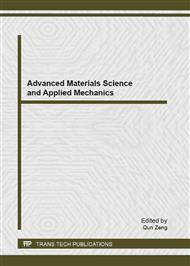p.88
p.94
p.100
p.105
p.111
p.115
p.119
p.123
p.128
Novel Microwave Reduction Sintering for Perovskite Anode
Abstract:
The La0.3Sr0.7Ti0.9Nb0.1O3 (LSTN) is a good anode material in solid oxide fuel cell (SOFC) due to its resistance to sulfur poison and carbon fiber deposition. The LSTN was studied by a novel microwave processing in activated carbon and flowing atmosphere of (5%H2+95%Ar). The pure perovskite structure is obtained for different microwave power and duration to indicate that the fast microwave reduction process could maintain stable perovskite structure. The conductivity of LSTN increases with the decrease of flow rate of 5%H2+95%Ar. More semiconducting characteristics but less metallic conductivities are achieved by microwave process. A stable microwave power 300W and a dwell time 12 min with an appropriate flow rate 40 cc/min can achieve the best conductivity of LSTN. The microwave reduction sintering obtains high conductivity of LSTN which is far higher than the one by conventional sintering at 1500°C-3 h.
Info:
Periodical:
Pages:
111-114
Citation:
Online since:
May 2013
Authors:
Keywords:
Price:
Сopyright:
© 2013 Trans Tech Publications Ltd. All Rights Reserved
Share:
Citation:


